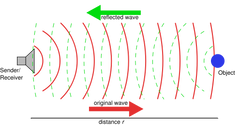At ReelSonar, we love answering customer questions on Facebook, and we post our most common questions on our blog and website. We often hear customers talk about wanting to test their iBobbers before taking them fishing, which is perfectly understandable. But unless you live near a lake, you’re probably limited to your bathtub or swimming pool for testing.

If this scenario sounds like you, then you may have noticed that the iBobber doesn’t show the correct water depth or maybe even shows the presence of fish. Clearly you don't keep fish in a chlorine-filled swimming pool, so what gives?
Don’t worry, your iBobber is not defective or broken, but to understand why you might get these readings, we have to discuss how sonar works.
Sonar is essentially a way to visualize your surroundings using sound instead of sight. Sound waves travel from a source, bounce off an object, and return to the source as echoes to navigate or locate objects. Man-made sonar technology takes its cues from the animal kingdom, where we see plenty of animals that use sonar to navigate or find prey instead of relying on their eyes.

Have you ever seen bats flying outside your house at dusk? Contrary to popular belief, bats are not blind, but they use sonar to hunt insects at night. A bat can even tell the size of an insect, its direction, and how far away it is by reading the intensity and pitch of the echoes.

Marine mammals are another classic example. Anyone who has watched a nature documentary on dolphins has probably heard their sonar, or echolocation. If you look closely at an Amazon River Dolphin, their eyes are so small that they’re essentially blind, so they rely on echolocation to navigate the murky river waters and locate prey.

Bat sonar can travel up to 17 m, but in water, dolphin sonar can reach farther, anywhere from 5-200 m, or 16-656 ft. However, the take-home message is that sonar requires a certain amount of distance to work. The iBobber works best in water depths of at least 4 feet. Otherwise, the sound waves will bounce back too quickly to provide accurate readings of the waterbed or the presence of fish. In addition, if the bottom of the swimming pool is curved, the sonar can bounce back and forth from one side to the other and confuse the iBobber or any other fish finder.
For our customers who want to test their new iBobbers, we recommend taking a trip to the nearest pond, lake, or other standing body of water and casting from the shore. As long as the water depth is approximately 5-7 feet, you should have no problems.

Please don’t hesitate to ask us questions about the iBobber on the ReelSonar Facebook page, or Tweet them to us at @ReelSonar. Otherwise, keep on fishing!
